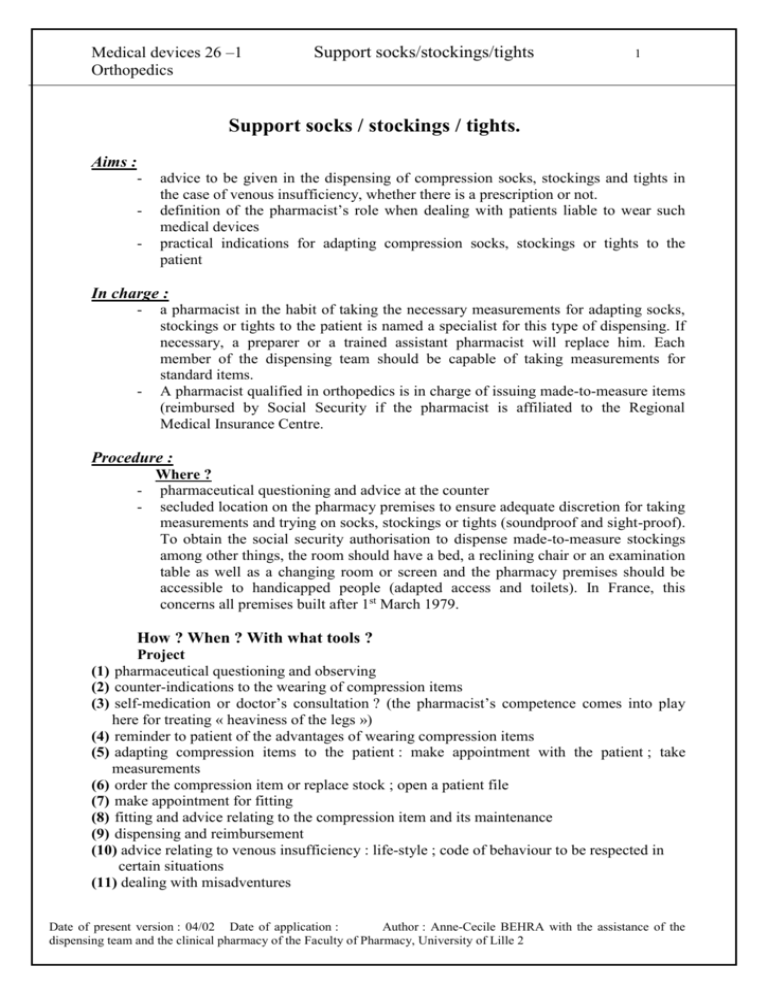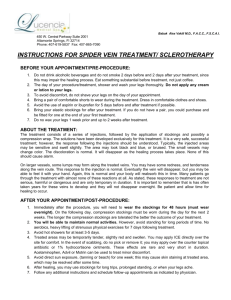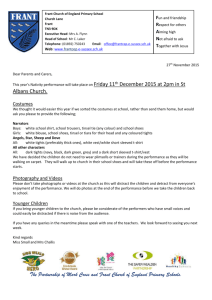Maternity tights
advertisement

Medical devices 26 –1 Orthopedics Support socks/stockings/tights 1 Support socks / stockings / tights. Aims : - advice to be given in the dispensing of compression socks, stockings and tights in the case of venous insufficiency, whether there is a prescription or not. definition of the pharmacist’s role when dealing with patients liable to wear such medical devices practical indications for adapting compression socks, stockings or tights to the patient In charge : - - a pharmacist in the habit of taking the necessary measurements for adapting socks, stockings or tights to the patient is named a specialist for this type of dispensing. If necessary, a preparer or a trained assistant pharmacist will replace him. Each member of the dispensing team should be capable of taking measurements for standard items. A pharmacist qualified in orthopedics is in charge of issuing made-to-measure items (reimbursed by Social Security if the pharmacist is affiliated to the Regional Medical Insurance Centre. Procedure : - Where ? pharmaceutical questioning and advice at the counter secluded location on the pharmacy premises to ensure adequate discretion for taking measurements and trying on socks, stockings or tights (soundproof and sight-proof). To obtain the social security authorisation to dispense made-to-measure stockings among other things, the room should have a bed, a reclining chair or an examination table as well as a changing room or screen and the pharmacy premises should be accessible to handicapped people (adapted access and toilets). In France, this concerns all premises built after 1st March 1979. How ? When ? With what tools ? Project (1) pharmaceutical questioning and observing (2) counter-indications to the wearing of compression items (3) self-medication or doctor’s consultation ? (the pharmacist’s competence comes into play here for treating « heaviness of the legs ») (4) reminder to patient of the advantages of wearing compression items (5) adapting compression items to the patient : make appointment with the patient ; take measurements (6) order the compression item or replace stock ; open a patient file (7) make appointment for fitting (8) fitting and advice relating to the compression item and its maintenance (9) dispensing and reimbursement (10) advice relating to venous insufficiency : life-style ; code of behaviour to be respected in certain situations (11) dealing with misadventures Date of present version : 04/02 Date of application : Author : Anne-Cecile BEHRA with the assistance of the dispensing team and the clinical pharmacy of the Faculty of Pharmacy, University of Lille 2 Medical devices 26 –1 Orthopedics Support socks/stockings/tights 2 Detailed description of the above 1. pharmaceutical questioning and observing - if there is no medical prescription * patient’s physiological condition : pregnancy ? * description of symptoms : keep in mind that there are 4 stages in the evolution of venous insufficiency [1], explain to the patient the stage he is in and, if necessary, advise him to see a GP (second stage, or even sooner) Stage 0 : heavy, swollen legs, slight problems which could result from some clearly defined circumstances warning sign in a patient who may be predisposed or suffering from aggravating factors. Stage 1 : onset of real functional problems : sore legs, tightening in the calves, burning sensation, cramps, swelling round the ankle, itching or night-time cramps in the calves, numbness, « pins-and-needles », twitching(mainly at night) + venules which may be dilated, purplish and/or twisted (varicosity) Treatment must be undertaken. Stage 2 : appearance of varicose veins, i.e. long, twisted, dilated veins (a few centimetres long) Stage 3 : skin affliction, that is dermatitis, microbial because of stasis, crackled, orange-coloured skin, pre-ulcer stage, ulcers, evolution towards deep vein thrombosis ; * what the patient has done about it so far * periods when the problems are most notable, when they ease off and when they get worse (characteristic of venous infections : problems in both legs, present during the day, worse late in the day, easing-off at night, when legs are raised or when walking…..) + aggravating factors (heredity, age, gender, unfavourable life-style (smoking, being overweight or immobile) [2] * Job : standing or sitting position over long period of time ? - If there is a medical prescription : age, rheumatic patient ….. to be able to assess the difficulty the patient might have in pulling on compression items - In both cases : progressive adaptation to the degree of compression required to help the patient adapt to wearing such medical accessories without remaining below the required compression level ; in this case, the symptoms may well persist and the venous illness continue to evolve . However, if pulling on the stocking is difficult, it is preferable to dispense a lower level of compression which will be worn rather than the correct one which will remain in the cupboard. (2) Counter-indications to the wearing of compression stockings [3,4,5,6,7] - serious problems of arterial perfusion - acute deep vein thrombosis - diabetic microangiopathy - acute hypodermatitis - oozing dermatosis - infections such as boils - clinically apparent cardiac insufficiency - allergy to latex Date of present version : 04/02 Date of application : Author : Anne-Cecile BEHRA with the assistance of the dispensing team and the clinical pharmacy of the Faculty of Pharmacy, University of Lille 2 Medical devices 26 –1 Orthopedics - Support socks/stockings/tights 3 non-healed wounds (3) self-medication or GP’s consultation - GP’s consultation confirmed varicose veins acute pains and unilateral swelling +/- breathing problems (i.e. deep vein thrombosis) sudden, acute pain as of embolism general worsening of a leg infection skin lesion around the ankle (malleolus) – risk of ulcer very hard calves : risk of phlebitis request for reimbursement - self-medication or patient under pharmacist’s care when : the description and observation of symptoms belong only to stage 0 or 1 at the most in the evolution of venous insufficiency ( see above). If in doubt, advise the patient to see a GP. (4) Reminder to the patient of the advantages of wearing compression items [1,6,7,8,9] It is important to insist on good compliance with the treatment and to be positive and convincing. With men, the term « socks » should be used rather than « stockings » or « tights ». It should be clearly explained that it is normal for the stocking or sock to feel tight round the ankle or heel. - enhanced comfort : legs feeling lighter and less painful (helping the resorption of the oedema) - improvement in blood circulation( favours valvular coaptation as well as an acceleration of the circulatory flow) - esthetic advantage (+ improvement in attractiveness of stockings) - rebalancing of the tissular metabolism through better oxygenation the advantages are obvious when the sock, stocking or tights are adapted to the stage in the evolution of the illness and are accepted by the patient effectiveness has been acknowledged by the National Evaluation Agency [1] (5) Adapting socks, stockings and tights to the patient Make an appointment Preferably in the morning when the oedema has receded. - at each renewal assess patient satisfaction note if there has been any morphological alteration weight ? pregnancy ? any problems ? need to apply ointment ? - If the patient has any difficulty pulling on the stockings : either increase steadily the compression level to reach that requested by the prescriber, or suggest superposing two medium-compression items (I or II) to obtain a high level of compression with - Date of present version : 04/02 Date of application : Author : Anne-Cecile BEHRA with the assistance of the dispensing team and the clinical pharmacy of the Faculty of Pharmacy, University of Lille 2 Medical devices 26 –1 Orthopedics Support socks/stockings/tights 4 - fewer practical problems [7,8,10], or recommend using devices which help : put a fine stocking underneath, wear fine gloves [latex (beware of allergies), or vinyl], use - an extender [Cornu-Thénard (labo Ganzoni), Eureka (Varitex], use a device to slide the foot in ( for leggings without feet) [7,11] avoid using level IV compression stockings or tights : choose bandages instead [7], as long as they are applied correctly ( choose bandages specifically conceived for width and/or elasticity) this question of prescribing level IV compression stockings may be discussed with the GP. - if the patient does not have a standard size or is obese : made-to-measure compression or bandages [7] - if the patient is a sportsperson : level I and II compression during effort and at rest, but not during competitions. If varicose veins are bad, medium or strong compression may be prescribed at rest and light compression during physical effort [8,12] - if the patient is pregnant : type II compression ; specific tights exist with adjustable waistband as pregnancy evolves - for long journeys : the effectiveness of wearing compression socks has been proven (fall in the number of cases of deep vein thrombosis in patients at risk) [13,14]. Explain clearly that hypnotic drugs should not be taken when wearing compression items. - Take measurements [2,9,11,15] : In the morning or after the lying position with the legs raised for at least 20 minutes. This should be by appointment and may be in the patient’s home. For each type of stocking – standard, maternity or made-to-measure – refer to the instruction sheet and plan [appendix 1]. For more complete explanations, see appendix 2. to adapt socks, stockings and tights as well as possible, manufacturers propose numerous modifications(taking-in, shortening, altering the bottom end of tights, open feet for deformations….) - choice of thread used [9,15] : see appendix 3 - choice of the appropriate compression stocking following the measurements and the table provided by the supplier (for a reimbursement by Social Security based on the reimbursement guide (reglementary tariff in the reimbursement of all medical devices), articles of type I, II and III, made-to-measure or not, fulfil the norms defined in the reimbursement guide and are certified). For measurements in between two sizes : decision on fitting, usually choice goes to the bigger. If one leg is fatter than the other, two pairs of different sizes should be taken. (6) Order the compression item or replace stock ; open a patient file - photocopy the sheet on which the measurements have been noted [appendix 1]. - Note down the date of issue. Possibility of letting the patient know by phone when it is time to renew. A copy of the file should be proposed to the patient. (7) make an appointment for the fitting : if possible, early in the morning Date of present version : 04/02 Date of application : Author : Anne-Cecile BEHRA with the assistance of the dispensing team and the clinical pharmacy of the Faculty of Pharmacy, University of Lille 2 Medical devices 26 –1 Orthopedics Support socks/stockings/tights 5 (8) fitting and advice relating to the compression item. (2,7,15) : - fitting * turn the sock, stocking or tights inside out. The patient should be lying down . * put the foot in, holding the stocking firmly by the heel until it is perfectly in place. In the case of « footless » stockings or leggings, put on a very thin special sock first or use a device. * The stocking should then be drawn up along the leg with smooth hands placed inside it as far as the knee, then little by little as far as the thigh (do not pull hard in one go). Pressure must be regular all over : adjust the area at the bottom of the leg and then the calf several times, and so on….(to avoid the formation of folds of wrinkles which could cause skin problems and even pain. * Finally, the sock used for ease should be removed, if leggings are concerned. - advice [10,7] : * the stocking may be put on in a lying position, before getting up. In this case, personal hygiene should be completed the evening before. However, if the legs swell too quickly after getting up, the stocking may be put on in the morning after washing but in a lying position if this is easier. To limit the delay between getting up and putting on the compression stockings, breakfast should not be taken before they are on. * dry the feet and legs carefully if they are wet. * put on a protective dressing in the case of skin lesions * do not apply any ointment to the legs and protect the tights from excessive perspiration * remember to take off rings and be careful with long nails -maintenance [2 ,9 ,15] * washing : by hand, with a gentle, neutral washing liquid for textiles or yellow soap. Ban normal washing-powder. * rinsing : in clean water, without wringing * drying : flat, away from any source of heat (not on a radiator or in a tumble-dryer * life-span : 4 to 6 months * do not make a « devil » out of compression stockings. If, from time to time, a patient with stabilised venous insufficiency, needs or just wants to feel free or « more beautiful », do not object to his taking off his stockings. Just make sure that this is exceptional.[10] (9) dispensing and reimbursement [16,17] : No reimbursement if the stockings are of the anti-fatigue type (not in classes I to IV). The text containing the list of reimbursed products and services specifies that the medical prescription for reimbursed stockings and tights is no longer limited. It should be « established on a special prescription, different from those for pharmaceutical products or for any other device. It should usually specify, over and above the description of the article, the nature and the location of the ailment justifying the Date of present version : 04/02 Date of application : Author : Anne-Cecile BEHRA with the assistance of the dispensing team and the clinical pharmacy of the Faculty of Pharmacy, University of Lille 2 Medical devices 26 –1 Orthopedics Support socks/stockings/tights 6 prescription and in certain cases, indications as to the correct application of the device (medical finality) ». (10) Advice relating to venous insufficiency (15,18,19,20,21) : see appendix 4. (11) Dealing with incidents Any incident should be referred to materiovigilance. - in the case of skin-peeling, worsened by the constant wearing of compression stockings by a patient with dry skin : microfibres and new mesh techniques solve the - problem in most cases. Do not hesitate to apply some hydrating cream in the evening after removing the tights. Warn the patient that the tights will deteriorate (loss of elasticity) if they are in contact with greasy substances ( ointment, liniment…) [10] Be sure to recommend a morning wash to remove all residual traces. - In the case of painful areas after wearing compression for a few hours [8] : toes : most often caused by inadapted shoes buy better shoes [adapted to the shape of the front of the foot – avoid shoes that are too narrow in front ; soles should allow for even pressure on all five metatarsians ; choose heels that are not too high – 2 to 3 cm]. ankles (malleolus) and shins : this occurs most often with strong compression because of greater pressure on low-curve zones reinforce the hollow zones with pads : better distribution of pressure. knee ( with knee-length socks) : usually because the sock is not long enough wear longer socks groin : usually because of a fold in the cloth check the floor-to-groin height (AG) stomach adapt the tights perfectly to the shape of the patient’s body. Do not hesitate to recommend maternity tights to stouter patients. - in the case of accidental deterioration : reimbursement possible in France if a new prescription is presented. remember that in the made-to-measure services of manufacturers, adjustments in length and width are possible for socks, stockings and tights…[11] Date of present version : 04/02 Date of application : Author : Anne-Cecile BEHRA with the assistance of the dispensing team and the clinical pharmacy of the Faculty of Pharmacy, University of Lille 2 Medical devices 26 –1 Orthopedics Support socks/stockings/tights 7 Appendix 1: patient’s measurements with a view to dispensing compression items Surname : First name : Date: Date of first issue : SOCKS Size: * STOCKINGS TIGHTS MATERNITY a * b * * * c d e * f * h * j * m x-y * h+j Graphs on : A-D * A-E A-F A-G * * * http://www.pharnet.com/ public/ then « questions de comptoirs » then « contention » A-M height Floor/waist Hip measurement Waist measurement Manufacturing size MAKE+REF. COLOUR COMPRESSION LEVEL EAN13 * If standard size. If the item is made to measure, take all the indicated measurements. Date of present version : 04/02 Date of application : Author : Anne-Cecile BEHRA with the assistance of the dispensing team and the clinical pharmacy of the Faculty of Pharmacy, University of Lille 2 Medical devices 26 –1 Orthopedics Support socks/stockings/tights 8 Appendix 2 : the taking of measurements for tights. Standard : - Place the foot at right angles with the leg - After each height measurement, take the circumference keeping the tape loose and not tight round the leg - Measurements should be taken from bottom to top - Circumferences are indicated in small letters, heights in capitals - Essential measuring point : b - For the height from the heel to the fold at the groin (A-G), the patient himself will hold the end of the tape LOWER CASE LETTERS = CIRCUMFERENCE UPPER CASE LETTERS = HEIGHT Ankle measurement (3 cms above the malleolus ): b Calf measurement : c Thigh measurement ( mid-height): f Floor/below knee (2 cms below bend in knee) : A - D Floor/ mid-thigh : A - F Floor/inside leg : A - G SHOE SIZE = P Date of present version : 04/02 Date of application : Author : Anne-Cecile BEHRA with the assistance of the dispensing team and the clinical pharmacy of the Faculty of Pharmacy, University of Lille 2 Medical devices 26 –1 Orthopedics Support socks/stockings/tights 9 Maternity tights Ankle measurement (3 cm above the malleolus ): b Floor/inside leg : A - G Navel/groin : h Measurement of pelvis (measure diagonally from navel to fold in buttocks): j Pant size: h + j Made-to-measure items CIRCUMFERENCES Extremity of foot : a From bridge of foot to edge of heel : x-y Ankle : b Calf : c Bend in knee : d Knee : e Mid-thigh : f Thigh where largest : m HEIGHT (INSIDE LEG) Floor/Bend in knee : A-D Floor/knee : A-E Floor/mid-thigh : A-F Floor/thigh : A-M FURTHER MEASUREMENTS FOR ONELEGGED TIGHTS Inside-leg measurement : A-G Height floor/waist Waist measurement Hip measurement Manufacturer’s size Date of present version : 04/02 Date of application : Author : Anne-Cecile BEHRA with the assistance of the dispensing team and the clinical pharmacy of the Faculty of Pharmacy, University of Lille 2 Medical devices 26 –1 Orthopedics Support socks/stockings/tights 10 Appendix 3 : Choice of materials - - Long silk-fibre cotton : high-quality natural fibre which is thermo-regulating. Microfibre : ultra-fine polyamide thread making the fibre softer and giving the stocking more stretch. Recommended for dry skin. Polyamide microfibre : thread made up of very fine fibres : soft to the touch and semi-opaque to the eye. Flat polyamide : fine thread offering transparency and softness. Textured polyamide : « moss » effect giving lengthwise stretch, soft and opaque touch ; these fibres are almost insensitive to creams and oils. Natural rubber or elastic : natural elastic thread adapted to obtain a high level of compression – its elasticity and flexibility make it easy to pull on and ensure good comfort. Lycra or elasthane : thread present in the tram to ensure therapeutic compression and in the mesh for good morphological adaptation and comfort. Appendix 4 : advice relating to venous insufficiency What must be avoided - standing or sitting too long without moving, - high heels, the « garrotte » effect of jeans, belts and girdles which are too tight, the « heat » effect of boots, socks - exposure or long-term contact with sources of heat : sun, overhot baths, saunas, some underfloor heating, hot-wax hair-remover - excess weight - sports where you have to mark time and strike hard (tennis, squash, volley-ball, handball) What is recommended - - - walk as much as possible, climb stairs, actively exercise the legs (daily flexion and stretching of the feet at work, in the plane, at the theatre, pedalling movement of the legs when lying on your back ….) remember not to cross your legs regularly take a few steps on tiptoe, which makes the calves work (contractions in the calves put pressure on the veins and help the blood to rise) choose a regular non-violent activity : swimming, cycling, gymnastics, yoga…. Raise the legs to sleep, by putting for example a cushion under the mattress or raising the bottom end of the bed In the evening, place your feet on a pouf or a stool Have lukewarm baths and shower (from bottom to top) the legs in cold water Massage the legs with suitable ointments, gels and creams from bottom to top Wear « anti-fatigue » stockings if « medical » ones do not suit. Date of present version : 04/02 Date of application : Author : Anne-Cecile BEHRA with the assistance of the dispensing team and the clinical pharmacy of the Faculty of Pharmacy, University of Lille 2





